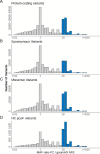This is a preprint.
Frequency enrichment of coding variants in a French-Canadian founder population and its implication for inflammatory bowel diseases
- PMID: 40791678
- PMCID: PMC12338899
- DOI: 10.1101/2025.07.11.25331388
Frequency enrichment of coding variants in a French-Canadian founder population and its implication for inflammatory bowel diseases
Abstract
The genetic features of founder populations with recent bottlenecks, causing some deleterious variants to rise to higher frequencies, can enhance the power of rare variant association studies. French Canadians from Quebec represent a recent founder population with a particular disease heritage comprising more than 30 prevalent Mendelian conditions. Here, we characterize coding variation in this founder population using exome sequencing data from 2,820 French-Canadian participants - patients with inflammatory bowel diseases (IBD), parents and controls from the Quebec IBD cohort. We find that 18% of rare coding variants are 10-100 times more frequent than in non-Finnish Europeans (NFE). A total of 4,133 missense and loss-of-function variants were significantly enriched with a median 28-fold enrichment, revealing the potential for genotype-phenotype associations in this population. We describe significantly enriched pathogenic variants, including those known to account for the increased prevalence of rare diseases in FC compared to other European descent populations, such as Agenesis of corpus callosum and peripheral neuropathy (SLC12A6) and Leigh Syndrome French Canadian type (LRPPRC). Finally, we investigate whether rare protein-coding variants, enriched in French Canadians by the founder effect, contribute to the risk of IBD using trio and case/control cohorts. In addition to replicating associations in NOD2 and IL23R, we identified new candidate association signals, including enriched variants in SLC35E3, and ARSA. Our findings show that, even in well-characterized founder populations like the French Canadians, there remains untapped potential for genetic discovery, revealing both rare and complex disease risk factors through enriched coding variation.
Keywords: French Canadian; Mendelian diseases; exomes; founder effect; genetic association; inflammatory bowel diseases.
Conflict of interest statement
Declaration of interests CB and VM serve as advisors for the start-up company Medeloop Inc. and hold shares in the company.
Figures



References
-
- Hästbacka J., de la Chapelle A., Kaitila I., Sistonen P., Weaver A., and Lander E. (1992). Linkage disequilibrium mapping in isolated founder populations: diastrophic dysplasia in Finland. Nat. Genet. 2, 204–211. - PubMed
-
- Blumenfeld A., Slaugenhaupt S.A., Axelrod F.B., Lucente D.E., Maayan C., Liebert C.B., Ozelius L.J., Trofatter J.A., Haines J.L., and Breakefield X.O. (1993). Localization of the gene for familial dysautonomia on chromosome 9 and definition of DNA markers for genetic diagnosis. Nat. Genet. 4, 160–164. - PubMed
-
- Kim H.I., Ye B., Gosalia N., Regeneron Genetics Center, Köroğlu Ç., Hanson R.L., Hsueh W.-C., Knowler W.C., Baier L.J., Bogardus C., et al. (2020). Characterization of exome variants and their metabolic impact in 6,716 American Indians from the southwest US. Am. J. Hum. Genet. 107, 251–264. - PMC - PubMed
Publication types
Grants and funding
LinkOut - more resources
Full Text Sources
